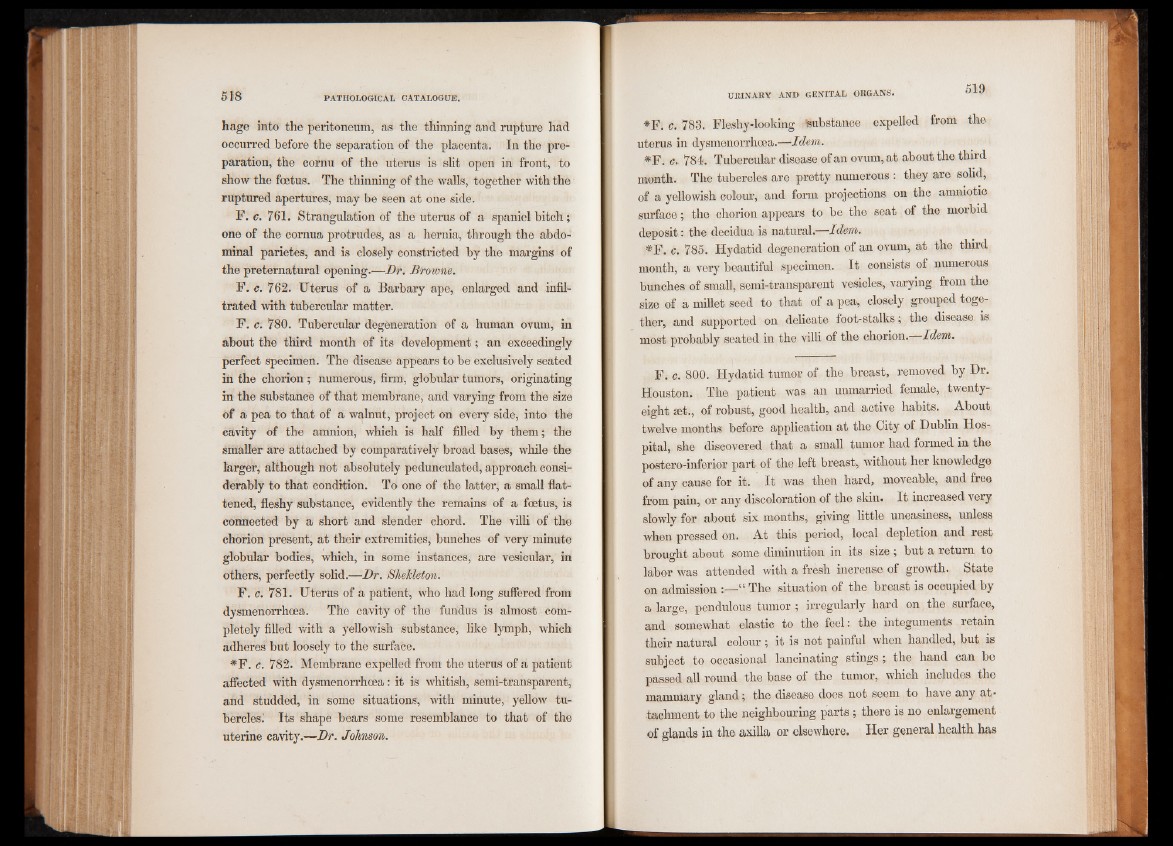
hage into the peritoneum, as the thinning and rupture had
occurred before the separation of the placenta. In the preparation,
the cornu of the uterus is slit open in front, to
show the foetus. The thinning of the walls, together with the
ruptured apertures, may be seen at one side.
F. c. 761. Strangulation of the uterus of a spaniel bitch;
one of the cornua protrudes, as a hernia, through the abdominal
parietes, and is closely constricted by the margins of
the preternatural opening.—Dr. Browne.
F. c. 762. Uterus of a Barbary ape, enlarged and infiltrated
with tubercular matter.
F. c. 780. Tubercular degeneration of a human ovum, in
about the third month of its development ; an exceedingly
perfect specimen. The disease appears to be exclusively seated
in the chorion ; numerous, firm, globular tumors, originating
in the substance of that membrane, and varying from the size
of a pea to that of a walnut, project on every side, into the
cävity of the amnion, whieh is half filled by them; the
smaller are attached by comparatively broad bases, while the
larger, although not absolutely pedunculated, approach considerably
to that condition. To one of the latter, a small flattened,
fleshy substance, evidently the remains of a foetus, is
connected by a short and slender chord. The villi of the
chorion present, at their extremities, bunches of very minute
globular bodies, which, in some instances, are vesicular, in
others, perfectly solid.—Dr. SheHeton.
F. c. 781. Uterus of a patient, who had long suffered from
dysmenorrhcea. The cavity of the fundus is almost completely
filled with a yellowish substance, like lymph, which
adheres but loosely to the surface.
#F. c. 782. Membrane expelled from the uterus of a patient
affected with dysmenorrhcea : it is whitish, semi-transparent,
and studded, in some situations, with minute, yellow tubercles^
Its shape bears some resemblance to that of the
uterine cavity.—Dr. Johnson.
*F. G. 783. Fleshy-looking »Substance expelled from the
uterus in dysmenorrhoea.—Idem.
*F. g. 781. Tubercular disease of an ovum, at about the third
month. The tubercles are pretty numerous : they are solid,
of a yellowish colour, and form projections on the amniotic
surface; the chorion appears to be the seat of the morbid
deposit: the decidua is natural.—Idem.
*F. c. 785. Hydatid degeneration of an ovum, at the third
month, a very beautiful specimen. It consists of numerous
bunches of small, semi-transparent vesicles, varying from the
size of a millet seed to that of a pea, closely grouped together,
and supported on delicate foot-stalks; the disease is
most probably seated in the villi of the chorion. Idem.
F. c. 800. Hydatid tumor of the breast, removed by Dr.
Houston. The patient was an unmarried female, twenty-
eight set., of robust, good health, and active habits. About
twelve months before application at the City of Dublin Hospital,
she discovered that a small tumor had formed in the
postero-inferior part of the left breast, without her knowledge
of any cause for it. It was then hard, moveable, and free
from pain, or any discoloration of the skin. It increased very
slowly for about six months, giving little uneasiness, unless
when pressed on. At this period, local depletion and rest
brought about some diminution in its size ; but a return to
labor was attended with a fresh increase of growth. State
on admission :—“ The situation of the breast is occupied by
a large, pendulous tumor ; irregularly hard on the surface,
and somewhat elastic to the feel: the integuments retain
their natural colour; it is not painful when handled, but is
subject to occasional lancinating stings; the hand can be
passed all round the base of the tumor, which includes the
mammary gland; the disease does not seem to have any attachment
to the neighbouring parts ; there is no enlargement
of glands in the axilla or elsewhere. Her general health has